Student Blog
What are OS/OT?

So you want to be a licensed OT in the US? ⟩
September 27, 2015, by Samar
Classes What are OS/OT?
You are already a practicing occupational therapist with a bachelor’s degree in OT and aspire to get your occupational therapy license to practice OT in the US . . . But you don’t know where to start!
According to American Association of Occupational Therapy (AOTA), effective July 31, 2013, the minimum criteria established by the National Board for Certification in Occupational Therapy (NBCOT) to be eligible for the initial certification examination, which required for practice:
- Completion of an Entry-Level Bachelor’s Degree in Occupational Therapy from a government authorized and/or WFOT approved college or university occupational therapy educational program AND a Post Professional Masters Degree in Occupational Therapy OR
- Completion of an Entry-Level Master’s Degree in Occupational Therapy from a government authorized and/or WFOT approved college or university occupational therapy educational program
What this means is that you need to first complete a post-professional master’s degree in Occupational Therapy. The one-year post-professional master’s program offered by USC is a great option for that. Second, apply for NBCOT’s Occupational Therapy Eligibility Determination (OTED) review. NBCOT will review your credentials for both your bachelor’s degree and master’s degree in OT to determine if you’re eligible to sit for the initial national certification examination. Once you’re determined eligible, you can apply and schedule for the NBCOT exam. After you pass the exam you’re ready for the final step for getting your state license. Depending on which state you plan to practice in, the requirements might be different. Check out the California Board of Occupational Therapy requirements. Other resources that you might find useful to check out are the AOTA website on working and studying in the US and the AOTA’s NBCOT exam prep website.
I hope this has been helpful in terms of having all of the information you might need in one place. Last but not least, if you have any more questions, feel free to contact me. I have been through the process recently and would be more than happy to help!
⋯

My Favorite Occupation: Socializing! ⟩
September 22, 2015, by Rashelle
Fieldwork What are OS/OT?
As humans, we are social creatures who crave and rely upon close interactions with others. The ability to socialize is a skill that most of us have, utilize daily, and may frequently take for granted. As occupational therapists we can analyze the art of socializing and can facilitate this complex process with individuals who may have difficulties doing so.
To give you an example, at the CHLA UCEDD (Children’s Hospital of Los Angeles, University Center of Excellence for Developmental Disabilities), where I completed my second Level I Fieldwork, I worked with children with selective mutism. These kids had extreme levels of anxiety in social situations, which prevented them from speaking to classmates, teachers, and even certain family members. In the treatment session, I observed how two children, who were both selectively mute, could overcome their apprehensions of speaking by engaging in meaningful activities. Since children love playing, we utilized fun, intrinsically motivating games, to encourage the children to speak to one another and to step out of their comfort zones.
Also at the UCEDD I was able to observe a social skills training program called the Secret Agent Society. This group allowed boys with high-functioning autism to role play being secret agents, with the mission of decoding the thoughts and emotions of others. Typically, children diagnosed on the autism spectrum have difficulties communicating and forming relationships. The Secret Agent Society creates an open and stimulating environment to target these social skills. The creative intervention also utilizes an interactive computer game, board game, and even “home mission” work sheets, to facilitate hands on learning and the application of learned skills to real life scenarios.
These fieldwork experiences at the CHLA UCEDD are just a few of the many, which have opened my eyes to the key role that occupational therapists can have in social skill development. Additionally, USC provides its own type of hands on learning, through the emphasis on engaging socially with students and staff outside of the classroom. Since USC’s occupational therapy program is the largest in the nation, there are many opportunities to socialize with a diverse variety of students. Also, USC encourages students to form closer relationships with faculty through mentor-mentee gatherings, faculty/student socials (organized by our student council professional development chairs), USC specific receptions at state or national conferences, and more!
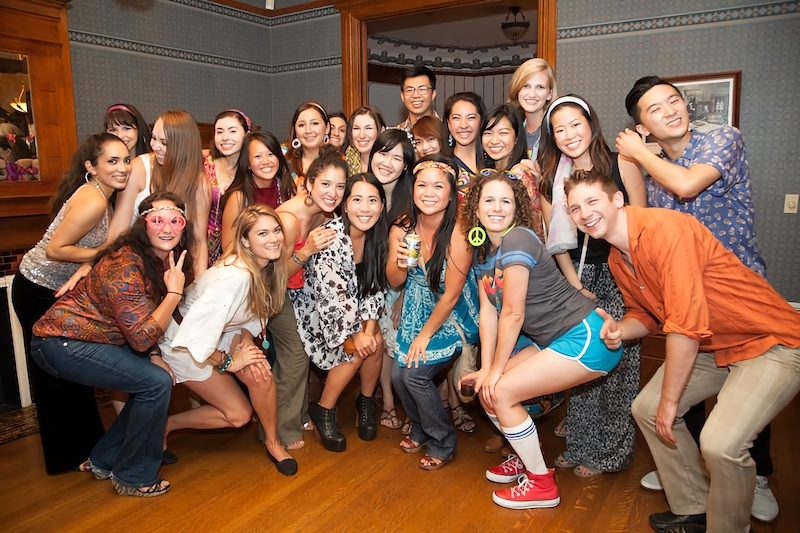
The division threw an end of the summer disco party for us!

Tailgating is a tradition at USC and what better way to do it than with all of your favorite colleagues?!
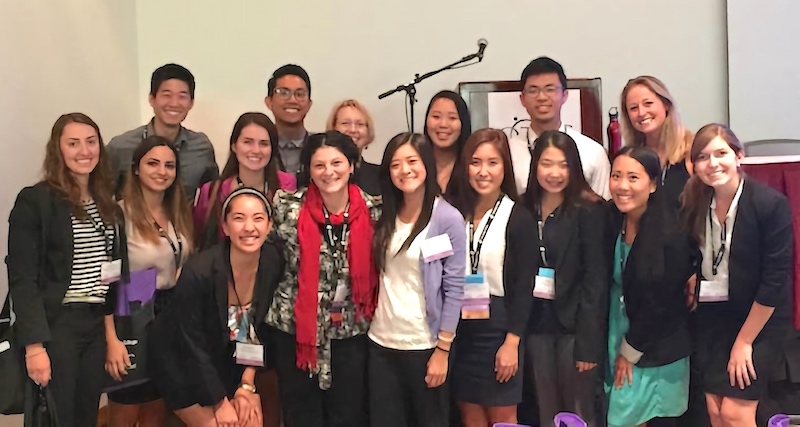
Last year at the 38th Annual OTAC Conference held in Pasadena, California we got to hang out with Dr. Rafeedie after she gave a captivating presentation to students from all over California
⋯

A New Project! ⟩
September 20, 2015, by Heather
Classes What are OS/OT?
Hey friends! I want to share with you a really awesome project that I started working on this week.
As part of my coursework in Occupation-Centered Programs for the Community, my classmate and I decided to work on a project focused on upper extremity ergonomics and proper body mechanics as it relates to one’s occupation. Through our volunteer and fieldwork experience in hand therapy clinics, we noticed that there was a lack of education regarding the importance of injury prevention and treatment of repetitive motion upper-extremity injuries. Specifically, we want to focus on creating a program that explores the prevention of repetitive motion injuries in musicians, and further investigate psychosocial factors that may contribute to the development or exacerbation of musculoskeletal disorders in the musician population.


I originally became interested in working with musicians after having an internship at the Santa Barbara Music Academy of the West’s Wellness Program. Here, I had the opportunity to work one-on-one with young musicians on how to stretch certain areas of their body and proper body mechanics for when playing their instruments. Many of the musicians were only in their early twenties and already experiencing pain in their hands, wrists, and shoulders. With education and a focus on ergonomics, musicians might be able to decrease the chances of injuring themselves or exacerbating an already existing injury. By the end of my internship, many of the musicians were already experiencing pain relief during their musical performances.
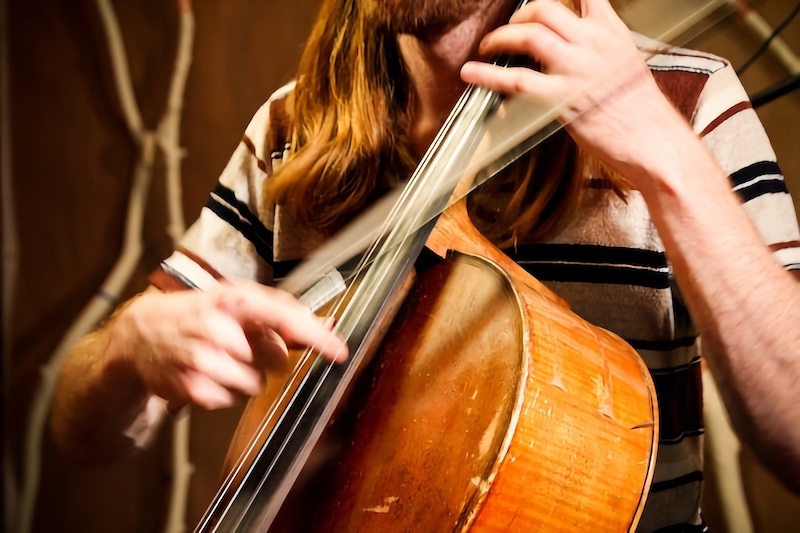

I look forward to learning more about this as I navigate the phenomenological experiences of these musicians and the health providers that treat them. Additionally, I hope to explore the possibility of spearheading an educational campaign centered around providing education for injury prevention that is specifically tailored to various areas of employment.

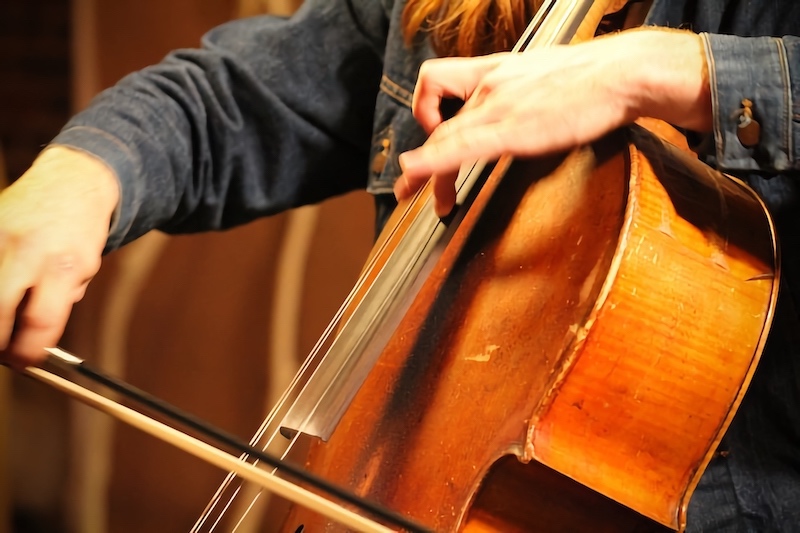
⋯

So you think you want to OT . . . ⟩
September 19, 2015, by Joe
Videos What are OS/OT?
So you think you want to OT . . . but you’re still trying to decide if it’s the right fit for you.
Check out some of these great resources on getting into OT:
The Many Faces of Occupational Therapists, a video from students at the University of British Columbia.
The Most Important Things You Need To Know About Becoming an Occupational Therapy Practitioner — A free ebook by Abby Brayton-Chung of OT Cafe and Christie Kiley of Mama OT (a graduate of USC!) that addresses many common questions about the profession, such as pursuing OT as a second career, deciding whether to become an OT or an OTA, and what OTs actually do in practice!
Resources for Beginning your OT Career from the American Occupational Therapy Association (AOTA)
Enjoy!
⋯

FUN with Hand FUNction! ⟩
September 17, 2015, by Ariel
Classes What are OS/OT?
Hello all! We learned some really awesome stuff in class this week, so I thought it might be neat to give you guys a taste of the ways our professors make our lessons come to life!
To give you a little background, I am currently completing my Pediatric Immersion. This means that I have six hours of lecture per week in Peds, which is accompanied by three hours of lab. I know it sounds like a lot of hours for one subject, but our enthusiastic teachers keep things fresh and exciting by incorporating hands-on (and tasty!) activities into our lectures and labs.
This week, we learned all about hand function — grasp development, fine motor control, and the ways that children experiencing difficulties with the use of their hands might benefit from strengthening exercises, compensatory strategies, and/or adaptive equipment in order to thrive.
One of the coolest things about occupational therapy is that to an outside observer, the activities we do with our pediatric patients might look just like play. But in graduate school, we’ve learned how to break down these specific activities (such as games) into their smallest components — a process called activity analysis — in order to develop our clinical reasoning skills. Ultimately, this will help us in practice when the time comes to assess our patients’ abilities, plan meaningful interventions, and understand the fundamental demands (mental, physical, environmental, and otherwise) required for a person to successfully complete any given task.
Here are some fun pictures of my classmates learning all about functional hand grasps!
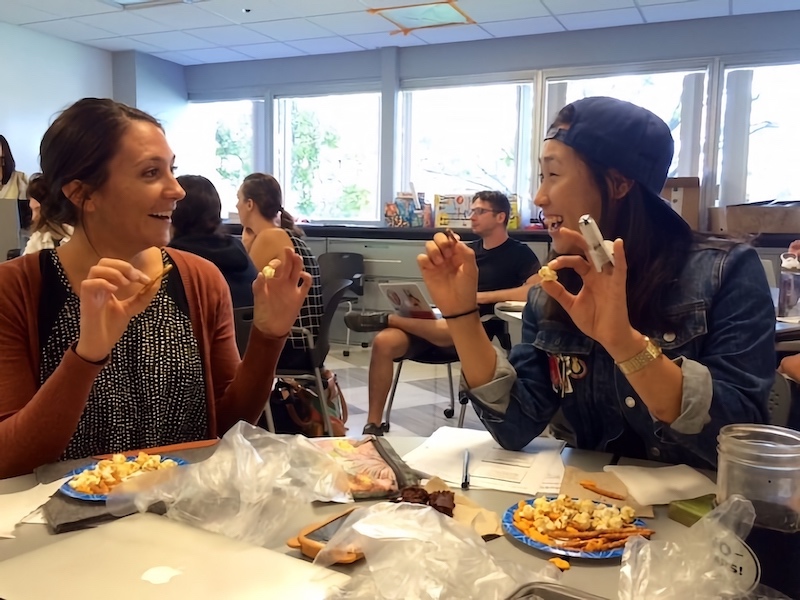
Cohort A Learns Pincer Grip!
For this activity, our professor brought in all kinds of yummy snacks, and then demonstrated each type of hand grasp we were learning by talking us through each position as we manipulated our food. Above are two classmates demonstrating the pincer grasp. So . . . Why is pincer grasp important? Well I’m so glad you asked! Pincer grasp employs the thumb and index finger to pick up small objects. It is a key developmental milestone that allows children the ability to feed themselves early on. Later, it is incredibly important in completing childhood tasks such as holding pencils, using utensils, and fastening things like buttons on a shirt.
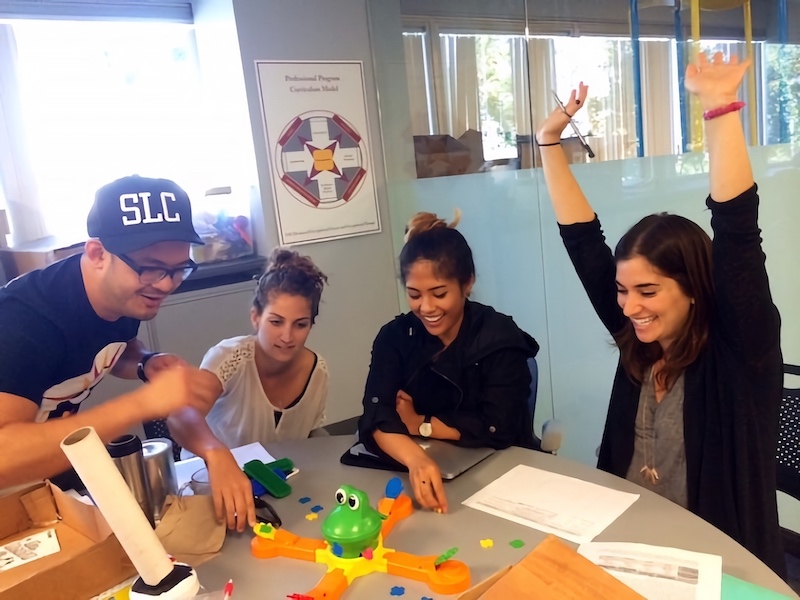
Cohort A Plays Hand Games!
For this activity, our teacher brought in tons of child-friendly games. As a group, we analyzed each to determine their age appropriateness and created descriptions of accompanying skills the game develops (such as fine motor, visual motor, or cognitive). We then connected these skills with real-life activities in which a child might need to engage throughout his or her day (e.g., dressing, writing, feeding, bathing). In the above photo, you’ll notice my classmates are playing Mr. Mouth, a game that requires participants to employ skills such as pincer grasp, scanning, attention, impulse control, and force gradation. While this might sound like a lot of fancy-schmancy words, in reality, building these fundamental skills will later allow the child to fully engage in social play, develop their impulses, and get around in their community.
If you haven’t realized by now, the way an occupational therapist can use activity analysis to deduce the therapeutic benefits of specific activities is pretty incredible!
⋯





